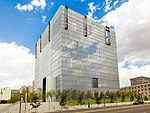900 South station
2005 establishments in UtahRailway stations in Salt Lake CityRailway stations in the United States opened in 2005TRAX (light rail) stationsUse mdy dates from July 2022

900 South is a light rail station in Downtown Salt Lake City, Utah, in the United States, served by all three lines of Utah Transit Authority's TRAX light rail system. The Blue Line provides service from Downtown Salt Lake City to Draper. The Red Line provides service from the University of Utah to the Daybreak community of South Jordan. The Green Line provides service from the Salt Lake City International Airport to West Valley City (via Downtown Salt Lake City). The station opened on September 19, 2005, and is operated by the Utah Transit Authority. 900 South is notable for being the first infill station constructed along an existing line of the TRAX system.
Excerpt from the Wikipedia article 900 South station (License: CC BY-SA 3.0, Authors, Images).900 South station
200 West, Salt Lake City
Geographical coordinates (GPS) Address Nearby Places Show on map
Geographical coordinates (GPS)
| Latitude | Longitude |
|---|---|
| N 40.750205555556 ° | E -111.89689722222 ° |
Address
900 South
200 West
84101 Salt Lake City
Utah, United States
Open on Google Maps








